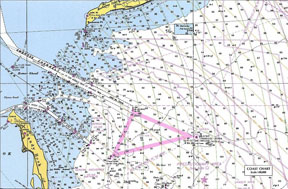AMBROSE CHANNEL, NJ

Ambrose Channel is the main shipping channel in and out of the Port of New York and New Jersey. The channel is considered to be part of Lower New York Bay and is located several miles off the coasts of Sandy Hook in New Jersey and Breezy Point, Queens in New York. Ambrose Channel terminates at Ambrose Anchorage, just south of the Verrazano Narrows Bridge, the gateway to New York Harbor.
Keep in mind the fact that the entire channel is in New York waters, and anglers must observe New York regulations when fishing here.
The entrance to the channel was marked by Ambrose Light which doubled as a staging area for pilot boats, most notably the Sandy Hook Pilots. Prior to the construction of the light tower in 1967, the channel was marked by the Ambrose Lightship, one of a class of lightships operated and maintained by the United States Coast Guard for the express purpose of marking main shipping channels for major ports. After several collisions, the light tower was redesigned and relocated in 1999, and finally decommissioned and removed in 2008.
Capt. Al Ristori of Al Ristori Charters runs his Sherri Berri there quite frequently for his customers and told me that, “Ambrose Channel fluking is often the best bet in the area when targeting truly big fluke. Sand eels are a natural food for ocean fluke, but squid and spearing and, when current allows, heavy bucktails and Gulp! takes big ones there.” He added that, “You need to bring heavy tackle for fishing Ambrose Channel, as heavy sinkers or jigs are required in deep waters and strong currents. Braided line is key for holding bottom away from pesky dogfish.”
The entire channel is productive at times, right up to the Verrazano Bridge. This is no place for one-handed spinning rods. There are better spots for a volume of fluke, but chances of a doormat hitting here are fluketastic. Break out those big baits and your odds of derricking up a beastly fluke are high, but be ultra-mindful of the heavy shipping traffic and get the heck out of the channel when a large ship is heading in or out of the bay.
